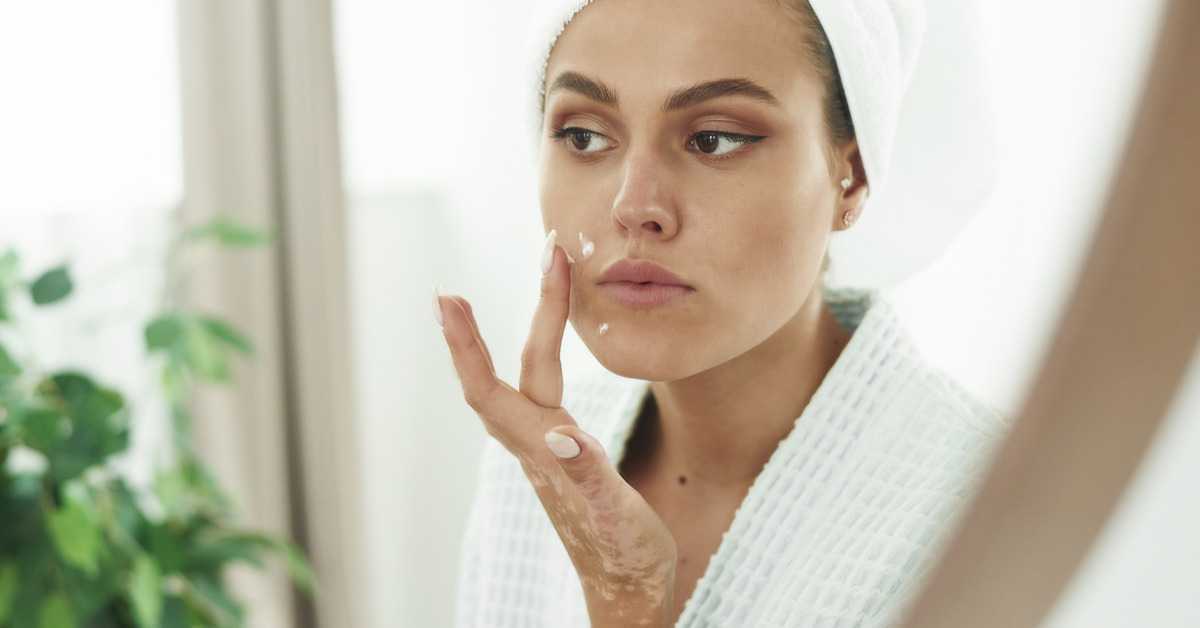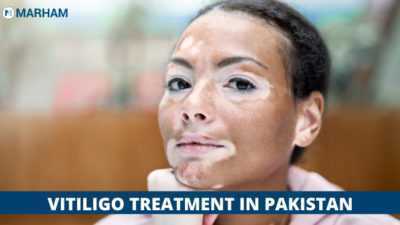Vitiligo is a skin disease that causes patches of skin color loss. The discolored areas typically grow larger over time. The condition can affect any part of the body’s skin. It can also harm your hair and the inside of your mouth. Here in this blog, we will discuss in detail Vitiligo Treatment in Pakistan.


Vitiligo Meaning in Urdu
وٹیلگو ایک ایسی حالت ہے جس میں جلد اپنے روغن خلیات (میلانوسائٹس) کھو دیتی ہے۔ اس کے نتیجے میں جلد، بالوں اور چپچپا جھلیوں سمیت جسم کے مختلف حصوں میں دھبے پڑ سکتے ہیں۔ وٹیلگو ایک بیماری ہے جس کی وجہ سے جلد کے دھبوں کی رنگت ختم ہوجاتی ہے۔
Vitiligo Symptoms
Symptoms of vitiligo include:
- Patchy loss of skin color, most commonly seen on the hands, face, and areas around body openings and the genitals.
- Premature whitening or greying of your scalp hair, eyelashes, brows, or beard
- Color loss in the tissues lining the inside of your mouth and nose (mucous membranes)
- Vitiligo can appear at any age, but it is most common before the age of 30.
Vitiligo Diagnosis
Before seeing Vitiligo Treatment in Pakistan, its important to see Vitiligo Diagnosis. Typically, the white patches on the skin are easily visible, but healthcare providers can use a Wood’s lamp, which shines ultraviolet (UV) light onto the skin to help distinguish it from other skin conditions. Consult some dermatologists for further discussion.


Vitiligo Causes
Vitiligo can be caused by:
- When macules appear in multiple locations on the body, this is referred to as generalized macules.
- Segmental refers to a condition that is limited to one side of the body or one area, such as the hands or face.
- Mucosal, affecting the mucous membranes of the mouth and/or genitals.
- Focal is a rare type in which the macules are concentrated in a small area and do not spread in a predictable pattern within one to two years.
- Trichome means that there is a white or colorless center, followed by a lighter pigmented area, and finally a normally colored area of skin.
- Another uncommon type of vitiligo is universal, which affects more than 80% of the skin. Consult dermatologist for further discussion.
Vitiligo Treatment
Lets discuss Vitiligo Treatment in Pakistan;
Camouflage Treatment
- Applying sunscreen with an SPF of 30 or greater. In addition, the sunscreen should protect against both ultraviolet B and ultraviolet A light (UVB and UVA). Sunscreen use reduces tanning, reducing the contrast between affected and normal skin.
- Makeup can help conceal depigmented areas. Dermablend is a well-known brand. * Hair dyes if vitiligo affects the hair.
- If the disease is severe, depigmentation therapy with the drug monobenzone may be used. This medication is applied to pigmented patches of skin and whitens them to match the vitiligo areas.


Repigmentation Treatment:
- Corticosteroids can be administered either orally (as a pill) or topically (as a cream put on the skin). It may take up to three months to see results. If the medication is used for an extended period of time, the doctor will monitor the patient for any side effects, which may include skin thinning or striae (stretch marks).
- Vitamin D analogs applied topically. Consult dermatologist for further discussion.
- Immunomodulators applied topically, such as calcineurin inhibitors.
Light therapy:
- For several months, two to three treatment sessions per week are required for narrow band ultraviolet B (NB-UVB). Excimer lasers emit ultraviolet light with a wavelength close to that of narrow-band UVB. Because it is delivered to small, targeted areas, it is better for patients who do not have widespread or large lesions. The combination of oral psoralen and UVA (PUVA) is used to treat large areas of vitiligo skin. This treatment is said to be very effective for people who have vitiligo in the head, neck, trunk, upper arms, and legs.
Surgery:
- Autologous (from the patient) skin grafts: Skin from one part of the patient is taken and used to cover another part. Scarring, infection, or failure to pigment are all possible complications. This is also known as mini grafting.
- Micropigmentation: A type of tattooing that is commonly used on the lips of vitiligo patients.
Counseling:
- Vitiligo can cause psychological distress and have an impact on a person’s outlook and social interactions. If this occurs, your caregiver may suggest that you seek counseling or join a support group.


So this was all about Vitiligo Treatment in Pakistan. But you should know that Vitiligo has no known cure. The goal of medical treatment is to achieve a uniform skin tone by either restoring color (repigmentation) or removing any remaining color (depigmentation). Camouflage therapy, repigmentation therapy, light therapy, and surgery are all common treatments.
Book an appointment now, to answer all your queries. You can book an appointment with the top dermatologists in Pakistan through Marham by calling at Marham helpline: 0311-1222398 or by online booking facility through the website or Marham mobile app.
Can’t Find The App?
| Android | IOS |
|---|---|
  |
  |
FAQ’s
How to avoid vitiligo from spreading?
Steroids applied topically Topical steroids are applied to the skin as a cream or ointment. They can sometimes stop the spread of white patches and even restore some of your natural skin color.
Can vitiligo be cured permanently?
Vitiligo has no known cure. The goal of medical treatment is to achieve a uniform skin tone by either restoring color (repigmentation) or removing any remaining color (depigmentation). Camouflage therapy, repigmentation therapy, light therapy, and surgery are all common treatments.
Does vitiligo spread from one person to another?
There is a widespread misconception that the disease can be transmitted through contact. Vitiligo, on the other hand, is not contagious and does not spread through contact. Another myth concerns dietary habits. For example, people used to blame vitiligo on sour foods, fish, white foods, and so on.
Are alopecia and vitiligo related?
One similarity between Vitiligo and Alopecia Areata is that they are both common autoimmune skin diseases. Vitiligo is caused by the destruction of melanocytes, resulting in white patches on any part of the body; alopecia, on the other hand, is characterized by the patchy hair loss on the scalp that can spread to other areas.

